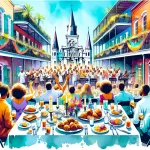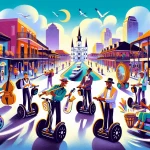Situated in New Orleans, the neighborhoods of Leonidas and West Carrollton offer a captivating blend of history, culture, and community spirit. These areas, formerly part of the town of Carrollton, have played a pivotal role in shaping the city’s identity through the centuries.
In This Article
TL;DR
- Leonidas and West Carrollton boast a rich heritage and diverse cultural influences.
- These neighborhoods have witnessed significant historical events that have shaped their physical and cultural landscapes.
- Today, they showcase a thriving community with local businesses, a strong sense of identity, and various recreational activities.
Historical Context of Leonidas and West Carrollton
The origins of Leonidas and West Carrollton date back to the early 18th century when Jean-Baptiste Le Moyne de Bienville, the founder of New Orleans, established a plantation in the area around 1719. The land remained dedicated to agriculture until the 1800s when the New Orleans Canal and Banking Company acquired and divided it into sections.
In 1835, the first house was built, marking the beginning of a new neighborhood within the city of New Orleans. This area, known as the town of Carrollton, encompassed what is now Leonidas and West Carrollton. The neighborhoods witnessed significant growth throughout the 19th century, with Dublin Street serving as the main commercial hub.
Geographical Layout and Key Features
Leonidas and West Carrollton are bounded by South Claiborne Avenue to the north, Leonidas and Fig Streets to the south, South Carrollton Avenue to the east, and the Mississippi River and Jefferson Parish to the west. These neighborhoods are part of the larger Uptown/Carrollton Area, known for its historic charm and vibrant community.
Notable landmarks within Leonidas and West Carrollton include the Camellia Grill, a beloved local diner; the Carrollton Streetcar Barn, a testament to the city’s transportation history; Palmer Park, a green oasis; the Water Works, a historic utility building; and the Oak Street commercial district, home to the famous Maple Leaf Bar and various shops and restaurants.
Demographic and Cultural Insights
Leonidas and West Carrollton are renowned for their cultural diversity, reflected in the local customs, festivals, and daily life. The neighborhoods have been shaped by the influence of various ethnic groups, including African Americans, Creoles, and immigrants from various parts of the world.
Today, these areas showcase a rich tapestry of cultures, with residents celebrating their heritage through vibrant festivals, music, and culinary traditions. The annual Oak Street Po-Boy Festival, for example, pays homage to the iconic New Orleans sandwich, while the Carrollton Boogie showcases the neighborhood’s musical talents.
Economic Landscape
The economic environment in Leonidas and West Carrollton is diverse, with a mix of local businesses, restaurants, and service industries driving the local economy. The Oak Street commercial district serves as a hub for small businesses, offering a range of shopping and dining options.
Employment opportunities in the area span various sectors, including healthcare, education, and hospitality. The presence of educational institutions, such as Tulane University and Loyola University, also contributes to the economic landscape, providing jobs and fostering a vibrant academic community.
Community and Lifestyle
Leonidas and West Carrollton are known for their strong sense of community and relaxed lifestyle. The neighborhoods offer a variety of housing options, from historic shotgun houses to modern apartments, catering to diverse preferences and budgets.
Community initiatives and local organizations play a vital role in fostering a sense of belonging and addressing local needs. Neighborhood associations, such as the Carrollton-Riverbend Neighborhood Association, work to preserve the area’s character while promoting positive change.
Education and Local Institutions
Education is a cornerstone of the Leonidas and West Carrollton communities, with several notable schools and educational institutions located within their boundaries. These include Incarnate Word School, Stuart Hall School, and Mater Delorosa School, among others.
Local government institutions, such as the New Orleans City Planning Commission, have played a crucial role in shaping the development and preservation of these neighborhoods. Efforts have been made to protect the historic character of Leonidas and West Carrollton while addressing the needs of residents.
Challenges and Opportunities
Like many neighborhoods in New Orleans, Leonidas and West Carrollton have faced challenges related to flooding, infrastructure, and economic development. However, these challenges have also presented opportunities for growth and revitalization.
Community-driven initiatives and partnerships with local organizations have aimed to address these challenges, focusing on improving drainage systems, enhancing public spaces, and attracting new businesses and investments to the area.
Cultural and Recreational Activities
Leonidas and West Carrollton are home to a vibrant cultural scene, with numerous festivals, events, and recreational activities that celebrate the neighborhoods’ unique identity. The annual Carrollton Boogie, held in Palmer Park, showcases local musical talents and brings the community together for a day of music, food, and fun.
Other popular events include the Oak Street Po-Boy Festival, which celebrates the iconic New Orleans sandwich, and the Carrollton Art Walk, where local artists showcase their works along the charming streets of the neighborhood.
Future Outlook and Development
The future of Leonidas and West Carrollton looks promising, with several planned developments and initiatives aimed at enhancing the quality of life for residents. These include efforts to revitalize commercial corridors, improve public transportation, and create more green spaces and recreational areas.
Community aspirations and projects, such as the proposed expansion of Palmer Park and the development of a community center, reflect the neighborhoods’ commitment to fostering a vibrant and sustainable environment for generations to come.






